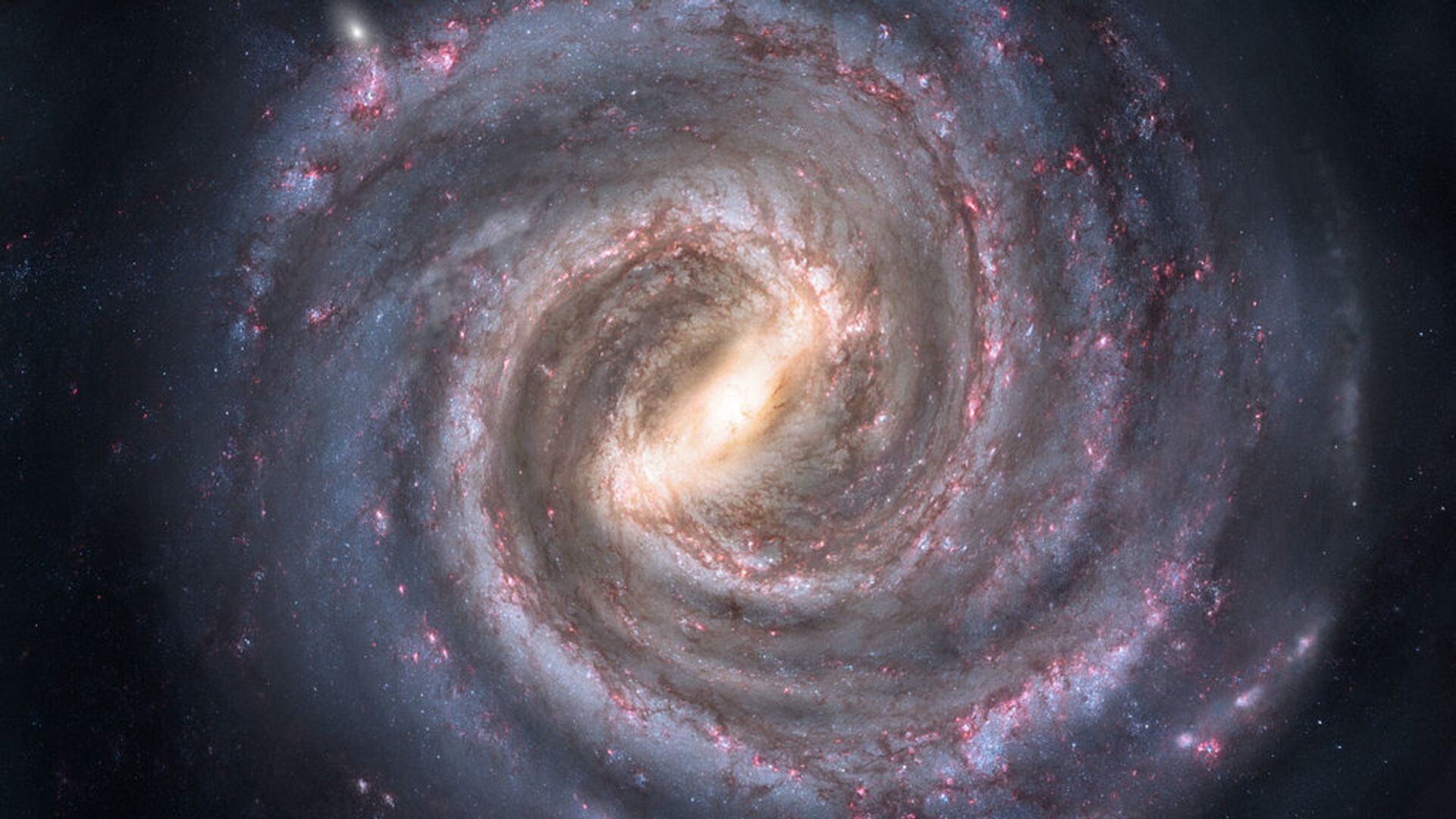https://sputnikglobe.com/20230603/-mysterious-newly-discovered-milky-way-threads-bewilder-scientists-1110870060.html
Mysterious Newly Discovered Milky Way Threads Bewilder Scientists
Mysterious Newly Discovered Milky Way Threads Bewilder Scientists
Sputnik International
Astronomers hope that the discovery will help them understand more about the spin of the Milky Way’s central supermassive black hole, located about 26,000 light-years from Earth.
2023-06-03T06:09+0000
2023-06-03T06:09+0000
2023-06-03T06:09+0000
beyond politics
us
south africa
telescope
astronomers
discovery
black hole
study
https://cdn1.img.sputnikglobe.com/img/107853/46/1078534683_0:225:1024:801_1920x0_80_0_0_68973250c618179c79d8725c9cd96dde.jpg
There are hundreds of horizontal cosmic threads that point towards the supermassive black hole at the heart of the Milky Way galaxy, a new study has revealed.The astronomers suggested that at the time, outflow from Sagittarius A*, the Milky Way’s central supermassive black hole, interacted with surrounding materials, which finally resulted in emergence of the horizontal galaxy filaments, each of which stretches five to ten light years through space."We found that these filaments are not random but appear to be tied to the outflow of our black hole," the scientist pointed out, admitting that he himself was also "actually stunned" when he saw these structures.He was referring to his team’s findings about 40 years ago, when the astrophysicists discovered a population of nearly 1,000 one-dimensional vertical filaments near the galaxy’s center. As compared to horizontal threads, vertical ones were much larger at up to 150 light years long each.The latest discovery was made with the help of the world’s most sensitive MeerKAT radio telescope based in the Northern Cape of South Africa. Yusef-Zadeh stressed in this regard that “If it wasn’t for MeerKAT these [new structures] wouldn’t have been detected; we’ve never been able to dedicate that amount of time to the center of the galaxy.”He also made it clear that studying the cosmic threads will help astronomers shed more light on the spin of the Milky Way’s central black hole. Yusef-Zadeh was echoed by Erika Hamden, an assistant professor of astronomy at the University of Arizona, who was cited by US media as saying that the study related to the black hole located about 26,000 light-years from Earth are “really exciting” and “demonstrate how beautiful the universe is.”Sagittarius A* “is the closest supermassive black hole to us, but it’s relatively quiet and therefore somewhat difficult to really study. But this work provides evidence that it was recently ejecting quite a lot of energy into space in the form of a jet and conical outflow,” Hamdem concluded.
https://sputnikglobe.com/20220906/fast-spinning-stars-of-dwarf-galaxy-orbiting-milky-way-could-be-source-of-mystery-gamma-rays-1100439397.html
south africa
Sputnik International
feedback@sputniknews.com
+74956456601
MIA „Rossiya Segodnya“
2023
Oleg Burunov
https://cdn1.img.sputnikglobe.com/img/07e4/09/0b/1080424846_0:0:2048:2048_100x100_80_0_0_3d7b461f8a98586fa3fe739930816aea.jpg
Oleg Burunov
https://cdn1.img.sputnikglobe.com/img/07e4/09/0b/1080424846_0:0:2048:2048_100x100_80_0_0_3d7b461f8a98586fa3fe739930816aea.jpg
News
en_EN
Sputnik International
feedback@sputniknews.com
+74956456601
MIA „Rossiya Segodnya“
Sputnik International
feedback@sputniknews.com
+74956456601
MIA „Rossiya Segodnya“
Oleg Burunov
https://cdn1.img.sputnikglobe.com/img/07e4/09/0b/1080424846_0:0:2048:2048_100x100_80_0_0_3d7b461f8a98586fa3fe739930816aea.jpg
discovery of horizontal cosmic threads, horizontal cosmic threads, milky way galaxy, supermassive black hole, vertical cosmic threads
discovery of horizontal cosmic threads, horizontal cosmic threads, milky way galaxy, supermassive black hole, vertical cosmic threads
Mysterious Newly Discovered Milky Way Threads Bewilder Scientists
Astronomers hope that the discovery will help them understand more about the spin of the Milky Way’s central supermassive black hole, located about 26,000 light-years from the Earth.
There are hundreds of
horizontal cosmic threads that point towards the supermassive black hole at the heart of
the Milky Way galaxy, a new study has revealed.
In the survey published on Friday, an international team of astrophysicists described the mysterious structures as elongated bodies of luminous gas that possibly originated a few million years ago.
The astronomers suggested that at the time, outflow from Sagittarius A*, the Milky Way’s central supermassive black hole, interacted with surrounding materials, which finally resulted in emergence of the horizontal galaxy filaments, each of which stretches five to ten light years through space.
Farhad Yusef-Zadeh, an astronomer at Northwestern University in Evanston, Illinois, and the study’s lead author, said in a statement that "It was a surprise to suddenly find a new population of structures that seem to be pointing in the direction of the black hole."
"We found that these filaments are not random but appear to be tied to the outflow of our black hole," the scientist pointed out, admitting that he himself was also "actually stunned" when he saw these structures.
Yusef-Zadeh also said that he and his colleagues “have always been thinking about vertical filaments and their origin," adding, "I'm used to them being vertical. I never considered there might be others along the plane [of the galaxy]."
He was referring to his team’s findings about 40 years ago, when the astrophysicists discovered a population of nearly 1,000 one-dimensional vertical filaments near the galaxy’s center. As compared to horizontal threads, vertical ones were much larger at up to 150 light years long each.
The latest discovery was made with the help of the world’s most sensitive MeerKAT radio telescope based in the Northern Cape of South Africa. Yusef-Zadeh stressed in this regard that “If it wasn’t for MeerKAT these [new structures] wouldn’t have been detected; we’ve never been able to dedicate that amount of time to the center of the galaxy.”
He also made it clear that studying the cosmic threads will help astronomers shed more light on the spin of the Milky Way’s central black hole.

6 September 2022, 13:34 GMT
Yusef-Zadeh was echoed by Erika Hamden, an assistant professor of astronomy at the University of Arizona, who was cited by US media as saying that the study related to the black hole located about 26,000 light-years from Earth are “really exciting” and “demonstrate how beautiful the universe is.”
Sagittarius A* “is the closest
supermassive black hole to us, but it’s relatively quiet and therefore somewhat difficult to really study. But this work provides evidence that it was recently ejecting quite a lot of energy into space in the form of a jet and conical outflow,” Hamdem concluded.





